Top Rankings
East Chambers Independent School District ranks among the top 20% of public school district in Texas for:
Category
Attribute
Graduation Rate
Highest graduation rate (Top 10%)
Diversity
Most diverse schools (Top 1%)
For the 2025 school year, there is 1 public middle school serving 356 students in East Chambers Independent School District. This district's average middle testing ranking is 5/10, which is in the bottom 50% of public middle schools in Texas.
Public Middle School in East Chambers Independent School District have an average math proficiency score of 34% (versus the Texas public middle school average of 40%), and reading proficiency score of 48% (versus the 52% statewide average).
Minority enrollment is 64% of the student body (majority Hispanic), which is less than the Texas public middle school average of 75% (majority Hispanic).
Overview
This School District
This State (TX)
# Schools
4 Schools
2,747 Schools
# Students
1,563 Students
1,489,538 Students
# Teachers
117 Teachers
103,135 Teachers
Student : Teacher Ratio
13:1
13:1
District Rank
East Chambers Independent School District, which is ranked #498 of all 1,196 school districts in Texas (based off of combined math and reading proficiency testing data) for the 2021-2022 school year.
The school district's graduation rate of 95% has stayed relatively flat over five school years.
Overall District Rank
#465 out of 1204 school districts
(Top 50%)
(Top 50%)

Math Test Scores (% Proficient)
43%
41%

Reading/Language Arts Test Scores (% Proficient)
52%
51%

Science Test Scores (% Proficient)
44%
46%

Graduation Rate
≥95%
90%
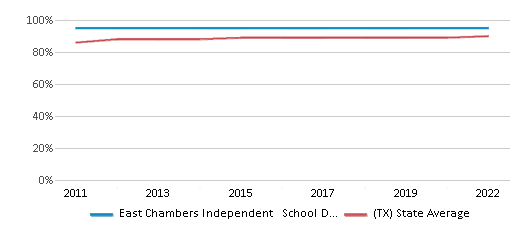
Students by Ethnicity:
Diversity Score
0.61
0.64
# American Indian Students
n/a
5,199 Students
% American Indian Students
n/a
n/a
# Asian Students
10 Students
77,599 Students
% Asian Students
1%
5%
# Hispanic Students
729 Students
795,444 Students
% Hispanic Students
47%
53%
# Black Students
114 Students
186,072 Students
% Black Students
7%
13%
# White Students
650 Students
378,957 Students
% White Students
41%
26%
# Hawaiian Students
1 Student
2,404 Students
% Hawaiian Students
n/a
n/a
# Two or more races Students
59 Students
43,863 Students
% of Two or more races Students
4%
3%
Students by Grade:
# Students in PK Grade:
132
15,212
# Students in K Grade:
97
21,462
# Students in 1st Grade:
90
22,752
# Students in 2nd Grade:
114
22,958
# Students in 3rd Grade:
95
22,862
# Students in 4th Grade:
108
22,563
# Students in 5th Grade:
105
30,190
# Students in 6th Grade:
117
326,610
# Students in 7th Grade:
132
406,424
# Students in 8th Grade:
107
414,179
# Students in 9th Grade:
129
56,165
# Students in 10th Grade:
116
48,628
# Students in 11th Grade:
114
42,213
# Students in 12th Grade:
107
37,320
# Ungraded Students:
-
-
District Revenue and Spending
The revenue/student of $13,759 is higher than the state median of $13,387. The school district revenue/student has stayed relatively flat over four school years.
The school district's spending/student of $13,360 is less than the state median of $14,116. The school district spending/student has stayed relatively flat over four school years.
Total Revenue
$22 MM
$74,029 MM
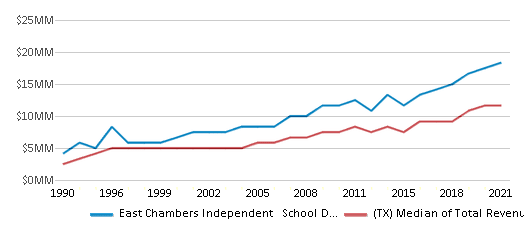
Spending
$21 MM
$78,063 MM
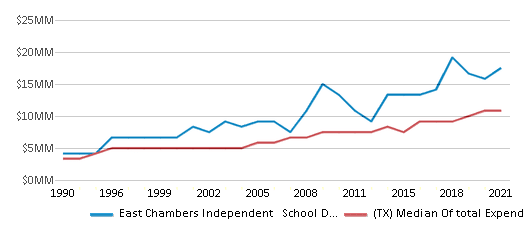
Revenue / Student
$13,759
$13,387
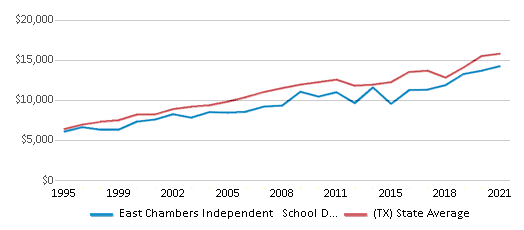
Spending / Student
$13,360
$14,116
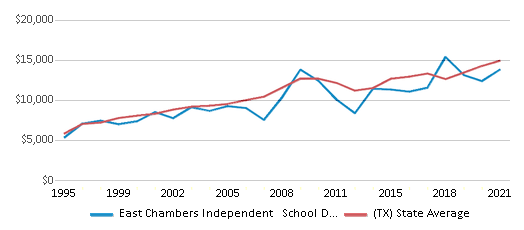
Best East Chambers Independent School District Public Middle Schools (2025)
School
(Math and Reading Proficiency)
(Math and Reading Proficiency)
Location
Grades
Students
Rank: #11.
East Chambers J High School
(Math: 34% | Reading: 48%)
Rank:
Rank:
5/
Bottom 50%10
1931 State Hwy 124
Winnie, TX 77665
(409) 296-4183
Winnie, TX 77665
(409) 296-4183
Grades: 6-8
| 356 students
Recent Articles

Year-Round Or Traditional Schedule?
Which is more appropriate for your child? A year-round attendance schedule or traditional schedule? We look at the pros and cons.

Why You Should Encourage Your Child to Join a Sports Team
Participating in team sports has a great many benefits for children, there is no doubt. In this article you will learn what those benefits are.

White Students are Now the Minority in U.S. Public Schools
Increasing birth rates among immigrant families from Asia and Central and South America, combined with lower birth rates among white families, means that for the first time in history, public school students in the United States are majority-minority. This shift in demographics poses difficulties for schools as they work to accommodate children of varying language abilities and socio-economic backgrounds.





